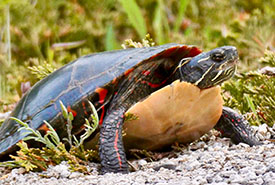Toppling hurdles for turtles

Painted turtle nesting (Photo by Rod Steinacher)
I have always loved turtles. So, when my first task as an intern with the Nature Conservancy of Canada (NCC) in midwestern Ontario was to conduct turtle surveys across the Saugeen Bruce Peninsula on Lake Huron, I got excited.
One of the things I love most about turtles is their resiliency. Turtles have survived on Earth since the time of the dinosaurs, and some species, including Ontario’s largest species — snapping turtle — can live for many decades. Their ability to thrive in challenging environments is inspiring. In Ontario, turtles spend the winter months hibernating underwater. By slowing their heart rate and metabolism, they survive on limited oxygen under the ice until spring.

Painted turtle hatchling (Photo by Chloe Robinson/NCC Staff)
Turtles are also important species within their ecosystems, which motivated NCC to conduct these surveys. They cycle nutrients, maintain water quality, disperse seeds, and act as both predators and prey. Plus, turtles are an umbrella species: protecting them and their habitats also protects areas of high biodiversity. So, figuring out where the turtles are helps to determine where to prioritize conservation efforts on the peninsula.

Turtle nests with protectors (Photo by Chloe Robinson/NCC Staff)
While looking for turtles on the Saugeen Bruce Peninsula, I noticed something interesting. Located along the roadside next to a wetland were square wooden boxes covered in wire mesh; these were protectors that were placed over turtle nests by local volunteers.
Nest protectors help deter predators and shield developing eggs from other disturbances. I had seen them before, but never so many in one place. I counted more than 20 boxes in less than one hundred metres along the road. It was clear that turtles were nesting here, a realization that was concerning to me because of how dangerous roads are to these animals.
Seven of Ontario’s eight native turtle species are now at risk, with road mortality being a major threat. Roads are especially dangerous for nesting females. Southern Ontario has a high density of roads; you can’t go more than 1.5 kilometres on average without running into a road (with the exception of some protected areas).
Females risk crossing roads in search of nesting sites, as they see the warm, loose gravel of unpaved roads and roadsides as desirable nesting sites, placing them and their eggs in even more danger. These areas are traps for developing turtles. Roadside nests can be crushed by cars, damaged by pollution and, because many animals like to travel along roads, these nests also face a higher risk of predation. Hatchlings would have to navigate traffic when they emerge from nests in the fall or spring.
Building safer nesting sites
I started to wonder what we could do to keep nesting turtles off the road. It turns out the answer is simple: give them another option.

Snapping turtle (Photo by Chloe Robinson/NCC Staff)
Artificial nesting sites can be built away from roads to give turtles a safe place to lay their eggs. These mounds of gravel and sand are specifically designed to mimic natural nesting habitat. Unlike roadside nests, these artificial sites give young turtles an advantage. Researchers have determined that turtles are more likely to hatch from nests laid at these sites and are just as healthy as those emerging from natural nesting locations. Artificial nesting sites can help turtle populations in two ways: by reducing the road mortality of nesting females and by increasing the survival of hatchlings.
This spring, when I head into the field during my second year with NCC, I’ll have a new turtle-related task. With the help of the TD Friends of the Environment Foundation, our team will begin constructing turtle nesting sites. We hope the turtles who previously laid their eggs on the roadside will skip the asphalt next year and lay their eggs safely at our sites instead.
Turtles have been around long before the invention of cars and the construction of roads. By protecting their habitat and implementing creative solutions like artificial nesting sites, we can ensure turtles — and the ecosystems that rely on them — continue to thrive.
The 2024 Conservation Intern Program in Ontario is proudly supported by 407 ETR.


